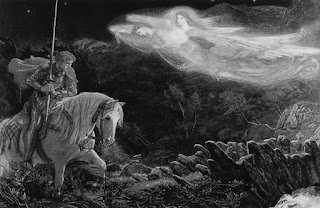American Grael Quest: Poe’s “Eldorado”

Sir Galahad - the Quest of the Holy Grail, 1870 by Arthur Hughes. “Eldorado” (1848) is Poe’s take on the classical grail quest—California Gold Rush edition—with a touch of swan song, to boot. The “ gallant knight ” is practically a lost Templar from Medieval Christendom and, as in the classic grail romance, he is traversing a vast expanse that has been laid waste—a wasteland. And the destiny he seeks is not an actual place, but a spiritual state of realization, a way to escape the false existence of the wasteland by finding the ultimate spiritual fulfilment. At the same time, the poem tracks the themes found in other Poe poems, namely the idea of a gilded childhood, and a happiness lost in adulthood, followed by a melancholic longing to recover that “ joy departed .” In the first stanza, our Knight is “ Gaily bedight ”—he is cheerfully attired, we can imagine him sporting bright colors and chic fashions as he goes forth, “ Singing a song .” But, by the secon...




